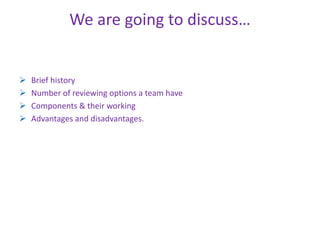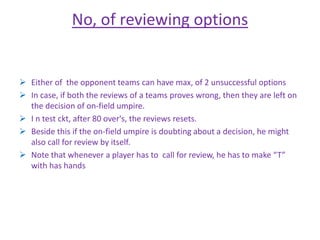DRS Umpire decision review system
- 1. UDRS Presented by- SHAKIL MUHAMMAD UET PESHAWAR PAKISTAN
- 2. TOPIC: UDRS or DRS Stands for (umpire Decision Review System) OR (Decision Review System). Basically a technology used in sport of cricket to review controversial decision made by on-field umpire.
- 3. We are going to discuss… Brief history Number of reviewing options a team have Components & their working Advantages and disadvantages.
- 4. History Initially tested in test cricket (india vs. srilanka) in 2008. In test ckt,ICC launched it officially for 1st time on 24 Nov, 2009 played b/w (pak & newzealand). In ODI ckt, was launched officially for 1st time in Jan,2011 during England's tour to Australia. Initially ICC made it mandatory in all international matches, but later on its use was decided upon the approval of both teams. To increase accuracy, amendments have also been made to it time to time.
- 5. No, of reviewing options Either of the opponent teams can have max, of 2 unsuccessful options In case, if both the reviews of a teams proves wrong, then they are left on the decision of on-field umpire. I n test ckt, after 80 over's, the reviews resets. Beside this if the on-field umpire is doubting about a decision, he might also call for review by itself. Note that whenever a player has to call for review, he has to make “T” with has hands
- 6. Components & working Composed of three parts. 1. HAWK EYE / EAGLE EYE: 2. HOTSPOT: 3. REAL TIME SNICKOMETER: HAWK EYE / EAGLE EYE: A ball tracking technology that plots ball trajectory to check whether the ball is going to hit the stumps or not..! It is like to check for LBW outs. Exp: let D=distance from strike end, (if D>2.5m OR travels more than 40cm before it is faced,)…is always declared not out.
- 8. 2. Hotspot An infrared imaging system that illumines the spot where the ball comes in contact with bat or pad Shortly, it checks out for the narrow contacts of ball with bat or pad Its accuracy is about 90-95% New high resolution cameras have been in use for the sack of accuracy
- 9. 3. REAL TIME SNICKMETER A system having an installed microphone in stumps so that to collect the sound produced by minor contacts when the ball comes in contact with the bat, Shortly, it checks out the result of caught by case and makes it clear whether the ball came in contact with the bat or not. It is like drawing a graph of sound waves.
- 10. Advantages & Disadvantages Purity has been brought into cricket. Rights of each player has been reserved. Interest of viewers have been enhanced in cricket. Sports & technology is getting mixed. It is like that cricket is losing its natural flavor because of technological interruption.
- 11. Any question…?? ELSE THANKSS TO ALL…!!










